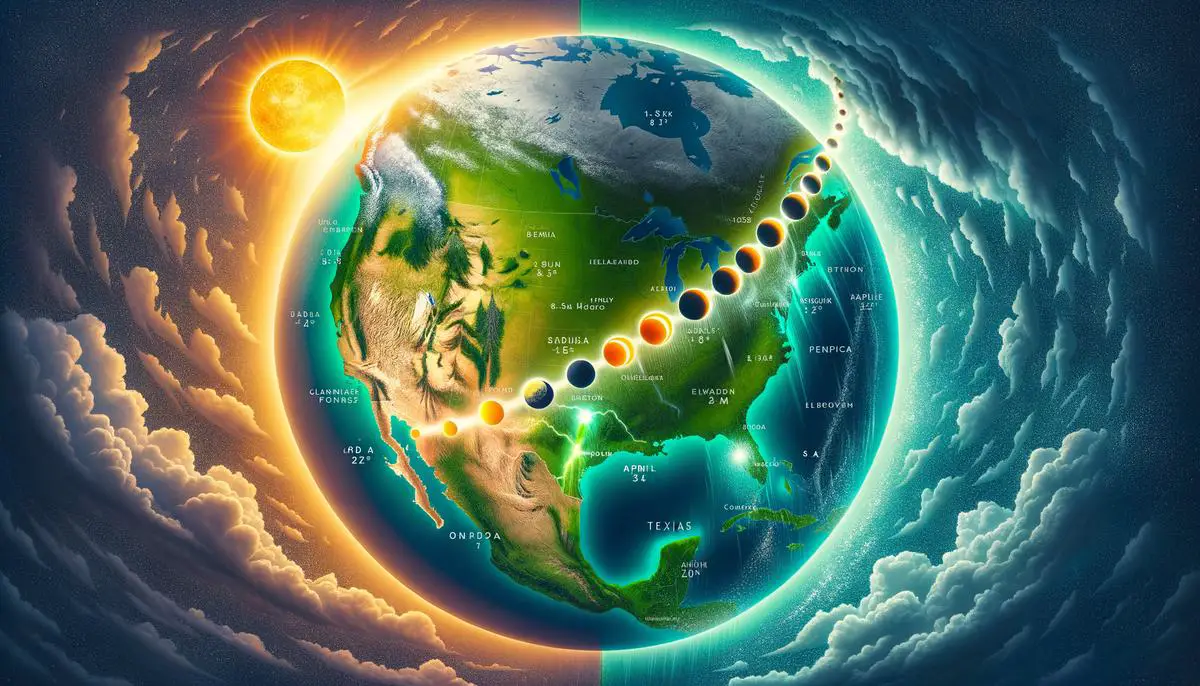As the April 8, 2024, total solar eclipse approaches, understanding the potential weather conditions becomes important for those planning to witness this astronomical event. From Texas to Maine, the path of totality will offer varying viewing experiences influenced by local weather patterns. This article aims to provide an overview of what observers might expect weather-wise across different states and how phenomena like El Niño could impact visibility. With insights into both local and global weather forecasting models, we help observers make informed decisions to improve their eclipse viewing experience.
State-by-State Weather Outlook
As the April 8, 2024, total solar eclipse draws closer, enthusiasts and planners across the United States are keen to determine the weather conditions on eclipse day. With the path of totality stretching from Texas to Maine, weather plays a crucial role in viewing this celestial event. Weather experts suggest that the further south your location, particularly in Texas, the better your odds of clear skies. Texas, known for its generally favorable climate during April, stands out as the state with the best viewing prospects, with conditions leaning towards sunshine and limited cloud cover.1 Thunderstorms are less of a concern in the early afternoon, potentially offering unobstructed views of the eclipse.
However, as one moves further north and east along the path of totality, the chance of encountering clouds or adverse weather conditions increases. Oklahoma and Arkansas enjoy relatively favorable weather odds, with only marginally higher risks of cloud cover compared to Texas. By the time the eclipse path reaches states like Illinois, Ohio, and Pennsylvania, viewers are cautioned about the likelihood of spring storms that could obscure the sky. These states experience a mix of seasonal weather during April, including potential rain or snow, which significantly increases the overall chance of cloudiness.2 Areas lying farther north along the eclipse's path are less likely to have the clear skies desired for optimal eclipse viewing, urging observers to plan with weather forecasts in mind to enhance their experience.

El Niño’s Influence on Eclipse Weather
As eclipse day approaches, El Niño could significantly shape weather conditions, drawing the attention of every eclipse enthusiast. El Niño, a climate pattern characterized by the warming of Pacific Ocean surface waters, often shifts weather dynamics across the globe. This phenomenon influences cloud coverage and precipitation patterns, especially in regions along the eclipse path. For those stationed from Mexico through southern Illinois, El Niño promises clearer skies. Studies indicate a decrease in cloud cover, by up to 14 percent in areas such as Texas, due to the El Niño effect.3 This change is important for eclipse watchers, as cloud-free skies are essential for an unobstructed view of the celestial spectacle.
However, it's important to understand that while El Niño can reduce cloud cover in certain locations, its impact varies geographically and is not a guarantee for every spot along the eclipse path. In the northern stretches and beyond Illinois, the effect of El Niño becomes less pronounced, leaving these areas subject to their typical April weather challenges—springtime storms and potentially problematic cloudiness. For observers in these zones, monitoring short-term weather forecasts as the eclipse nears becomes even more critical. The interaction between El Niño's influence and local weather patterns will dictate the final conditions, shaping an interesting backdrop for the total solar eclipse of 2024. Preparation, coupled with a readiness to adapt plans based on the latest meteorological insights, will be key for those committed to witnessing this event under the clearest skies possible.

Weather Forecasting and Eclipse Planning
Weather forecasts are invaluable for anyone planning to witness the total solar eclipse on April 8, 2024. Knowing the probable weather conditions is crucial, as it can greatly influence decisions such as where to view the eclipse from and whether contingency plans need to be activated. Meteorologists and climate scientists draw from historical weather data and current models to forecast conditions along the eclipse's path. These predictions can help eclipse chasers identify spots with the highest likelihood of clear skies, ensuring an unobstructed view of this astronomical phenomenon. As the event nears, these forecasts become more detailed, offering insights days or even hours before the eclipse, fine-tuning the quest for the perfect viewing site.
It's important to approach weather forecasts with both hopefulness and pragmatism. The dynamic nature of weather means that forecasts can only offer guidance rather than guarantees. The ability to quickly interpret and react to last-minute forecasts on and leading up to eclipse day will be vital. Successful eclipse viewing might involve mobility — being ready to travel to an alternate location based on the latest weather updates. Arranging travel routes, understanding local geography, and identifying potential viewing spots in advance become part of the eclipse-chasing experience. Staying informed through credible meteorological sources and platforms specialized in astronomical events enables eclipse enthusiasts to maximize their chances of witnessing this celestial event, reflecting a blend of careful planning and adaptability guided by the latest weather forecasts.

Local Versus Global Weather Models
Understanding the nuances between local and global weather models is crucial when predicting weather conditions for events like the April 8, 2024, total solar eclipse. Local weather models, often referred to as short-range models, focus on a smaller geographic area with higher precision, offering detailed forecasts about cloud cover, precipitation, and wind patterns up to three days in advance. These models prove invaluable for final planning stages, giving eclipse chasers specific insights a few days before the event that guide their final viewing location decisions. With refined calculations and high-resolution data, they pinpoint localized weather phenomena, crucial for determining if a small shift in location could mean the difference between witnessing the eclipse under clear skies or under a blanket of clouds.
Global weather models, including long-range models such as the GDPS, GFS, and ECMWF, provide broader forecasts that cover extensive areas and extend up to two weeks ahead.4 These models are essential for early planning, offering an overview of larger weather patterns that may influence eclipse day weather. They can highlight potential high-pressure systems or storm tracks crossing the eclipse path, inviting further scrutiny as the event draws closer. For both seasoned eclipse enthusiasts and casual observers, merging insights from both model types creates a robust strategy. By initially leaning on global models for understanding broader patterns and later refining plans through local models' precise forecasts, observers maximize their chances of clear-sky viewing, combining the understanding of celestial phenomena with the science of meteorology to make eclipse viewing a achievable experience.

- National Weather Service. Climate of Texas. NOAA. Accessed April 5, 2023.
- Haby J. U.S. climate in April. ThoughtCo. Published February 28, 2021. Accessed April 5, 2023.
- Zerecero M. El Niño could mean clear skies for eclipse viewing in 2024. AccuWeather. Published March 15, 2023. Accessed April 5, 2023.
- World Meteorological Organization. Numerical weather prediction. Accessed April 5, 2023.
![]()
